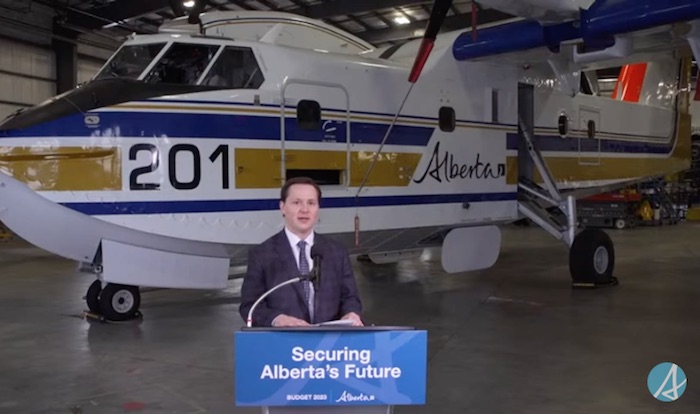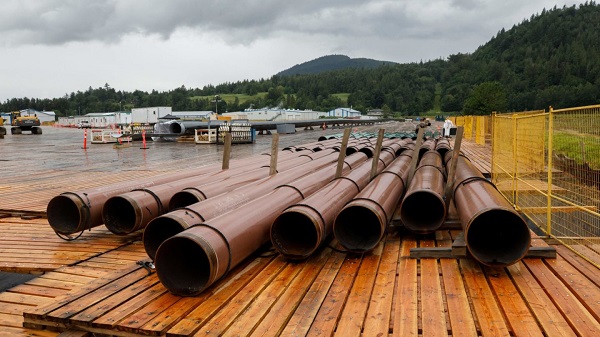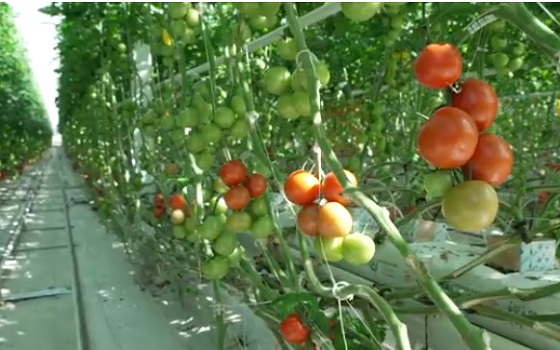Alberta
$30 million investment to help develop national transportation logistics hub at Red Deer Regional Airport

News release from the Province of Alberta
Investing in the Red Deer Regional Airport
Budget 2023 is investing $30 million to expand the Red Deer Regional Airport, clearing the way to develop a national transportation logistics hub in central Alberta.
As Alberta’s government continues its focus on growing and diversifying the economy, an investment in the Red Deer Regional Airport will provide new opportunities in central Alberta. Improvements will support the development of a shipping and receiving hub in central Alberta and attract new investment opportunities to create high-paying jobs.
“Alberta’s airports play a critical role in strengthening and diversifying our economy by expanding access to markets, as we don’t have direct access to tidewater. This investment will allow additional aviation cargo and logistics services, which will not only provide new travel options and get more products to market but also create jobs and help attract new investment to central Alberta.”
The expansion will support the growth of rural communities in central Alberta while enhancing the safety of local residents and airport users by creating an additional emergency access to the airport and the Hamlet of Springbrook. This new funding builds on a $7.5-million grant from Alberta’s government in 2022-23 for the airport to repair and upgrade its runway.
“This is definitely exciting news. The Red Deer Regional Airport is situated along one of the busiest transportation hubs in the province. This expansion will provide huge economic benefits to central Alberta.”
“The city and county recognize the Red Deer Regional Airport as an economic catalyst. The city, as a joint appointer for the airport with the county, is working together to be a key logistics hub based on our prime location. Thank you to the Province of Alberta for their investments in central Alberta.”
“We are glad this government has recognized the unique opportunity the airport and central Alberta can play in expanding our economic impact through diversification. We already have a tenant looking to expand their business as a result of this positive development. By building the road north, we now have the opportunity to access the additional 220 acres, which we hope will bring in cargo, aircraft repair and other airline-related services. This expansion project will also result in a new passenger terminal allowing for 737 aircraft passenger service.”
“Air Spray has partnered with the Red Deer airport for over 50 years. We are the largest business at the airport, employing over 150 highly trained aviation professionals. Air Spray is delighted with the news of this major investment at the Red Deer airport. This investment allows Air Spray to move forward with our expansion plans to add additional hangar space at the airport.”
Funding through Budget 2023 will support north end road construction and civil works, including water sanitation, stormwater and fibre optics, to Township Road 374 to support new business opportunities for the north end land development. The development of the north end road will also create additional emergency access to the airport and will increase safety for the community as it continues to grow.
“As the MLA for Red Deer-North and as a resident of Red Deer, I know this expansion will be a welcomed addition for the community. This expansion will be an asset to the transportation corridor, as it will attract new passenger and cargo services, improve tourism and create jobs. I am happy to see further investments that will support our booming community.”
“Centrally located on the dynamic Calgary-Edmonton corridor, the Red Deer Regional Airport enjoys great competitive advantages. This transformative $30-million capital investment for the airport will leverage those advantages, increasing the economic capacity of the airport, thereby increasing economic activity and prosperity in Red Deer and central Alberta.”
Budget 2023 secures Alberta’s future by transforming the health-care system to meet people’s needs, supporting Albertans with the high cost of living, keeping our communities safe and driving the economy with more jobs, quality education and continued diversification.
Quick facts
- Alberta’s aviation and aerospace industries employ more than 18,000 people (2022, Statistics Canada).
- These industries contributed $1.5 billion to the province’s GDP in 2021.
- The province is home to three low-cost Alberta-based carriers – Lynx Air, Swoop and Flair Airlines.
- Alberta’s government created the Strategic Aviation Advisory Council in 2020 to provide expert advice to government on how aviation and aerospace can increase economic development opportunities, expand markets and create jobs in the province.
Alberta
The case for expanding Canada’s energy exports

From the Canadian Energy Centre
For Canada, the path to a stronger economy — and stronger global influence — runs through energy.
That’s the view of David Detomasi, a professor at the Smith School of Business at Queen’s University.
Detomasi, author of Profits and Power: Navigating the Politics and Geopolitics of Oil, argues that there is a moral case for developing Canada’s energy, both for Canadians and the world.
CEC: What does being an energy superpower mean to you?
DD: It means Canada is strong enough to affect the system as a whole by its choices.
There is something really valuable about Canada’s — and Alberta’s — way of producing carbon energy that goes beyond just the monetary rewards.
CEC: You talk about the moral case for developing Canada’s energy. What do you mean?
DD: I think the default assumption in public rhetoric is that the environmental movement is the only voice speaking for the moral betterment of the world. That needs to be challenged.
That public rhetoric is that the act of cultivating a powerful, effective economic engine is somehow wrong or bad, and that efforts to create wealth are somehow morally tainted.
I think that’s dead wrong. Economic growth is morally good, and we should foster it.
Economic growth generates money, and you can’t do anything you want to do in social expenditures without that engine.
Economic growth is critical to doing all the other things we want to do as Canadians, like having a publicly funded health care system or providing transfer payments to less well-off provinces.
Over the last 10 years, many people in Canada came to equate moral leadership with getting off of oil and gas as quickly as possible. I think that is a mistake, and far too narrow.
Instead, I think moral leadership means you play that game, you play it well, and you do it in our interest, in the Canadian way.
We need a solid base of economic prosperity in this country first, and then we can help others.
CEC: Why is it important to expand Canada’s energy trade?
DD: Canada is, and has always been, a trading nation, because we’ve got a lot of geography and not that many people.
If we don’t trade what we have with the outside world, we aren’t going to be able to develop economically, because we don’t have the internal size and capacity.
Historically, most of that trade has been with the United States. Geography and history mean it will always be our primary trade partner.
But the United States clearly can be an unreliable partner. Free and open trade matters more to Canada than it does to the U.S. Indeed, a big chunk of the American people is skeptical of participating in a global trading system.
As the United States perhaps withdraws from the international trading and investment system, there’s room for Canada to reinforce it in places where we can use our resource advantages to build new, stronger relationships.
One of these is Europe, which still imports a lot of gas. We can also build positive relationships with the enormous emerging markets of China and India, both of whom want and will need enormous supplies of energy for many decades.
I would like to be able to offer partners the alternative option of buying Canadian energy so that they are less reliant on, say, Iranian or Russian energy.
Canada can also maybe eventually help the two billion people in the world currently without energy access.
CEC: What benefits could Canadians gain by becoming an energy superpower?
DD: The first and primary responsibility of our federal government is to look after Canada. At the end of the day, the goal is to improve Canada’s welfare and enhance its sovereignty.
More carbon energy development helps Canada. We have massive debt, an investment crisis and productivity problems that we’ve been talking about forever. Economic and job growth are weak.
Solving these will require profitable and productive industries. We don’t have so many economic strengths in this country that we can voluntarily ignore or constrain one of our biggest industries.
The economic benefits pay for things that make you stronger as a country.
They make you more resilient on the social welfare front and make increasing defence expenditures, which we sorely need, more affordable. It allows us to manage the debt that we’re running up, and supports deals for Canada’s Indigenous peoples.
CEC: Are there specific projects that you advocate for to make Canada an energy superpower?
DD: Canada’s energy needs egress, and getting it out to places other than the United States. That means more transport and port facilities to Canada’s coasts.
We also need domestic energy transport networks. People don’t know this, but a big chunk of Ontario’s oil supply runs through Michigan, posing a latent security risk to Ontario’s energy security.
We need to change the perception that pipelines are evil. There’s a spiderweb of them across the globe, and more are being built.
Building pipelines here, with Canadian technology and know-how, builds our competitiveness and enhances our sovereignty.
Economic growth enhances sovereignty and provides the resources to do other things. We should applaud and encourage it, and the carbon energy sector can lead the way.
Agriculture
Growing Alberta’s fresh food future

A new program funded by the Sustainable Canadian Agricultural Partnership will accelerate expansion in Alberta greenhouses and vertical farms.
Albertans want to keep their hard-earned money in the province and support producers by choosing locally grown, high-quality produce. The new three-year, $10-milllion Growing Greenhouses program aims to stimulate industry growth and provide fresh fruit and vegetables to Albertans throughout the year.
“Everything our ministry does is about ensuring Albertans have secure access to safe, high-quality food. We are continually working to build resilience and sustainability into our food production systems, increase opportunities for producers and processors, create jobs and feed Albertans. This new program will fund technologies that increase food production and improve energy efficiency.”
“Through this investment, we’re supporting Alberta’s growers and ensuring Canadians have access to fresh, locally-grown fruits and vegetables on grocery shelves year-round. This program strengthens local communities, drives innovation, and creates new opportunities for agricultural entrepreneurs, reinforcing Canada’s food system and economy.”
The Growing Greenhouses program supports the controlled environment agriculture sector with new construction or expansion improvements to existing greenhouses and vertical farms that produce food at a commercial scale. It also aligns with Alberta’s Buy Local initiative launched this year as consumers will be able to purchase more local produce all year-round.
The program was created in alignment with the needs identified by the greenhouse sector, with a goal to reduce seasonal import reliance entering fall, which increases fruit and vegetable prices.
“This program is a game-changer for Alberta’s greenhouse sector. By investing in expansion and innovation, we can grow more fresh produce year-round, reduce reliance on imports, and strengthen food security for Albertans. Our growers are ready to meet the demand with sustainable, locally grown vegetables and fruits, and this support ensures we can do so while creating new jobs and opportunities in communities across the province. We are very grateful to the Governments of Canada and Alberta for this investment in our sector and for working collaboratively with us.”
Sustainable Canadian Agricultural Partnership (Sustainable CAP)
Sustainable CAP is a five-year, $3.5-billion investment by federal, provincial and territorial governments to strengthen competitiveness, innovation and resiliency in Canada’s agriculture, agri-food and agri-based products sector. This includes $1 billion in federal programs and activities and $2.5 billion that is cost-shared 60 per cent federally and 40 per cent provincially/territorially for programs that are designed and delivered by provinces and territories.
Quick facts
- Alberta’s greenhouse sector ranks fourth in Canada:
- 195 greenhouses produce $145 million in produce and 60 per cent of them operate year-round.
- Greenhouse food production is growing by 6.2 per cent annually.
- Alberta imports $349 million in fresh produce annually.
- The program supports sector growth by investing in renewable and efficient energy systems, advanced lighting systems, energy-saving construction, and automation and robotics systems.
Related information
-

 espionage2 days ago
espionage2 days agoWestern Campuses Help Build China’s Digital Dragnet With U.S. Tax Funds, Study Warns
-

 Focal Points1 day ago
Focal Points1 day agoCommon Vaccines Linked to 38-50% Increased Risk of Dementia and Alzheimer’s
-

 Automotive1 day ago
Automotive1 day agoThe $50 Billion Question: EVs Never Delivered What Ottawa Promised
-

 Business2 days ago
Business2 days agoCanada invests $34 million in Chinese drones now considered to be ‘high security risks’
-

 Alberta11 hours ago
Alberta11 hours agoAlberta introducing three “all-season resort areas” to provide more summer activities in Alberta’s mountain parks
-

 Health1 day ago
Health1 day agoThe Data That Doesn’t Exist
-

 Economy2 days ago
Economy2 days agoAffordable housing out of reach everywhere in Canada
-

 Business20 hours ago
Business20 hours agoStorm clouds of uncertainty as BC courts deal another blow to industry and investment





